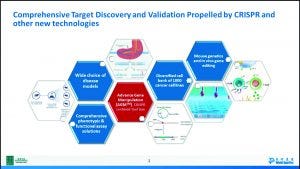- Sponsored Content
Comprehensive Target Discovery and Validation at HDB–WuXi AppTecComprehensive Target Discovery and Validation at HDB–WuXi AppTec
August 4, 2021
Sponsored by WuXi AppTec
Presented by: Shelly (Fang) Zhang, director II, exploration biology team leader,
HD Biosciences–WuXi AppTec
Novel target discovery and validation are the most crucial steps in successful drug development. Zhang presented her company’s evolving advanced gene manipulation (AGM) program, which is propelled by application of clustered regularly interspaced short palindromic repeats (CRISPR) and CRISPR-associated protein_9 (Cas9) technologies. The AGM platform supports target discovery and validation for conventional biologics and new modalities. She highlighted a number of technologies in development and their applications in immunology. Her examples began with gene editing in human and mouse primary immune cells.
 Cell lines are generated through gene knockout, knock-in, knock-down, and overexpression. A CRISPR guide library screens for synthetic lethality, drug modifiers, and the ubiquitin pathway. The technology can be used with primary cells including virus immune cell types and induced pluripotent stem cells (iPSCs). Downstream processing uses phenotypic acids to enhance target manipulation and incorporates other cutting-edge modalities and capabilities to support target discovery and validation. Zhang provided an overview of library screen procedures and types of screens that her company can provide, including customized libraries.
Cell lines are generated through gene knockout, knock-in, knock-down, and overexpression. A CRISPR guide library screens for synthetic lethality, drug modifiers, and the ubiquitin pathway. The technology can be used with primary cells including virus immune cell types and induced pluripotent stem cells (iPSCs). Downstream processing uses phenotypic acids to enhance target manipulation and incorporates other cutting-edge modalities and capabilities to support target discovery and validation. Zhang provided an overview of library screen procedures and types of screens that her company can provide, including customized libraries.
Her next examples were of CRISPR knockout procedures. Cancer cell lines with single- or double-target knockouts were generated using CRISPR–Cas9 technology, demonstrating that it provides an effective approach particularly for multiple target manipulation. In another case showing CRISPR-based knock-in for drug resistance studies, the potency shift in mutant cells suggested mutation as a mechanism for drug resistance. Other examples showed how CRISPR base editing can provide precise genetic modulations, with xCas9 validated by Sanger sequencing and next-generation sequencing (NGS). Zhang noted how advanced CRISPR prime-editing technologies provide higher precision, higher efficiency, and increased versatility.
The CRISPR platform has been expanded to perform target manipulation in a number of human and mouse primary immune cells. She summarized results validated by fluorescence-activated cell sorting (FACS)_and Sanger sequencing that enabled multiple downstream functional studies — including reverse transcription-polymerase chain reaction (RT-PCR) and enzyme-linked immunosorbent assay (ELISA) for cytokines — in different types of primary immune cells. The company’s comprehensive in vitro immune assay platform supports target validation and mechanistic studies in different types of immune cells. Studies include biomarker profiling, metabolic assessments, and proliferation assays and biomarker profiles for peripheral blood mononuclear cells (PBMCs), T cells, natural-killer cells, and monocytes. Each immune cell contains its own set of cytokines, and the platform can further evaluate the impact of target knockout in each type of immune cell.
The company has expanded its proteolysis targeting chimera_(PROTAC)_platform to work with prime immune cells. A turnover time of roughly one week ensures sufficient time for a downstream functional assessment, especially for nonproliferating primary immune cells. Her example showed high delivery efficiency and an excellent assay window in the pooled primary cells with stability up to 20+ days and 384-wp high-throughput screening capability. She noted that this approach provides a solution for novel and undruggable targets in tough primary immune cells.
Ongoing work is supporting new modality developments for TCR-T/CAR-T. HDB’s adoptive T-cell therapy platform has developed >90% high-efficiency delivery systems, with further developments in progress to boost accuracy and minimize side effects. Zhang also described development of an antibody–oligonucleotide conjugate (AOC) platform. Its rational and strategic assay design validates the siRNA target and surface receptor for siRNA-Ab/ligand conjugation by in-parallel target cells rather than mRNA/protein expression profiling in control cells.
Another ongoing project centers on cell-panel safe-harbor CRISPR knock-in barcoding. Used for drug screening of 10–20 pooled lines in vitro/in vivo, it robustly boosts screening efficiency. The technology also is applicable for tumor heterogeneity studies. The final example showed CRISPR barcoding expanded to 300–400 frequently used cancer lines.
You May Also Like






